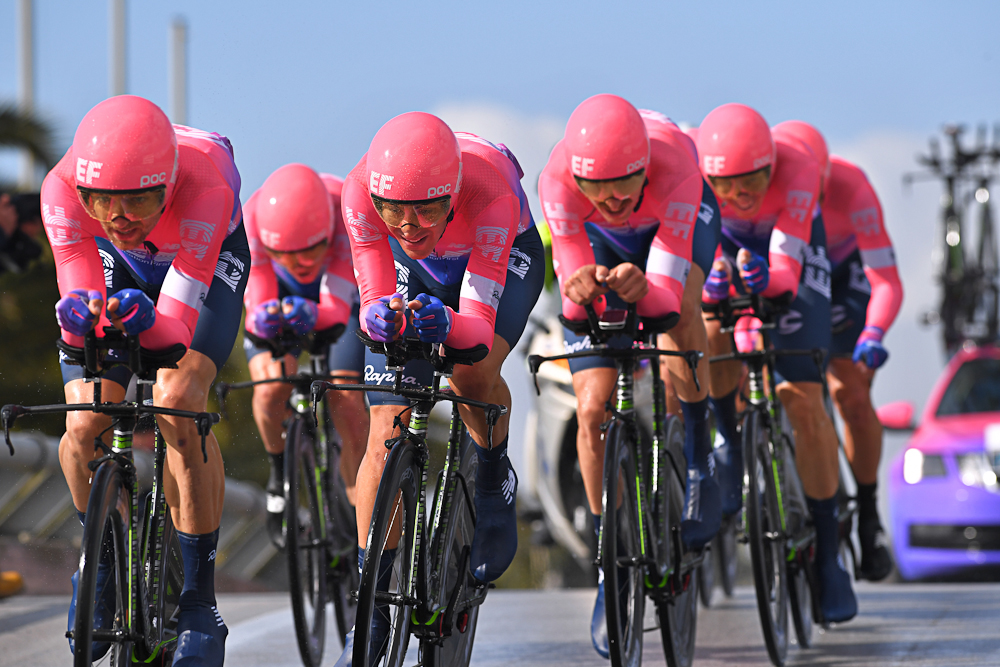Technical TTT kicks off 2019 Vuelta a Espana - Preview
Short but complex urban course will put teams through their paces

The 2019 Vuelta a España’s opening team time trial in Torrevieja is only 13.4 kilometres long, but with technical sections, possible coastal crosswinds and a ‘hidden’ uphill segment, there are plenty of challenges for the race’s 22 squads.
The Vuelta has started its recent opening time trials on a beach, outside an art museum and even on a giant batea - a raft in Galicia for growing oysters - so it’s possibly no surprise that Saturday’s start location is equally unusual: the edge of a salt lagoon.
A quarter of Spain’s salt comes from Torrevieja, the start town, and one of the stranger features of its 800-year-old industry is that the lagoons where the salt evaporates shine pink and blue because of the minerals they contain.
The Vuelta’s opening team time trial rapidly moves away from a lagoon, however (for the record this one shines pink) and gets down to cycling business as usual after crossing under a busy A-road on a flat and fairly straight access road leading away from the salt-processing buildings.
After about a kilometre, the course turns left at a crossroads into the town itself for the rest of a completely urban route that snakes through Torrevieja in a shape similar, barring a couple of wiggles at the beginning and end, to a stretched out, upside-down letter ‘U’.
There are two sharp right-angle turns on this opening section as it rolls past an unremarkable, never ending stream of small shops and other businesses. The first takes the course hard left after two kilometres onto a wider avenue. However, the first big landmark of the TTT comes before the road angles back right and broadens out onto a lengthy, steady climb.
The gradient on this first third of the course, which doesn’t look so difficult in the route book, is never that steep, just a couple of percent at most, and sometimes completely flat. But it’s definitely going to make itself felt, particularly as it continues steadily for about two kilometres.
Get The Leadout Newsletter
The latest race content, interviews, features, reviews and expert buying guides, direct to your inbox!
The climb continues when the road first narrows through a residential area, then broadens out after a left hand kink into a wide-open two lane highway between yet more tall blocks of flats and scrubland, with the sea glinting a kilometre or so away on the right. It’s an ascent for power riders, rather than pure climbers, but it’s going to suck away at the riders’ energy before the much more technical second half.
Cross-wind battles
Headwinds forecast for the evening, or cross-winds coming off the sea here could well be a factor, particularly as the road is so exposed. But where riders could notice it the most is when, after seven kilometres, the road suddenly plunges downhill on a fast drop to the sea. The drop is split only by a big right hand bend off the main highway and onto a narrower beach road, leading them down to the coastline, with about five kilometres to go.
This second, very different segment of the time trial, is mainly along an urban coast road heading south, with the beaches on the left - one named, intriguingly, the playa de los locos, the beach of the mad people - and the main city on the right.
The teams won’t be able to admire the beach views though, on a fast but technical course that is well-surfaced, but which swoops, dips and curves almost non-stop as it picks its way along the line of the coast. Once again the wind, particularly if it has picked up in the evening - as often happens on the Spanish coast- could be a big factor.
After a quick dash round a headland covered in yet more beach shops with two kilometres to go, the TTT’s final segment takes the teams back through the old town on narrower roads, before heading out to the finish on a seafront.
The differences on a course of just 13 kilometres between the top teams should be minimal. But the unpredictable and very varied nature of the terrain, the hot weather and the fact we’re into the final third of the season, with many riders feeling the pace of seven months on the bike, could make it a tougher challenge than predicted.
Just as a reference point, when the Vuelta last held a similar length team time trial of 13 kiometres in the region was in nearby Benidorm, in 2011. The time gaps between winners Leopard Trek and the last team on the results sheet, Andalucia, was 64 seconds - nearly five seconds a kilometre, and they could be of a similar margin this time round, too.
Alasdair Fotheringham has been reporting on cycling since 1991. He has covered every Tour de France since 1992 bar one, as well as numerous other bike races of all shapes and sizes, ranging from the Olympic Games in 2008 to the now sadly defunct Subida a Urkiola hill climb in Spain. As well as working for Cyclingnews, he has also written for The Independent, The Guardian, ProCycling, The Express and Reuters.
